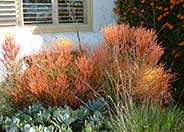
Common name:Sticks on Fire Pencil Tree
Botanical name:Euphorbia tirucalli 'Sticks on Fire'
In frost free areas, Euphorbia can become a 30' tree but in colder areas, it is often knocked back by frost. It can be single or multiple trunked. It has green cylindrical branches that are about the diameter of a pencil. Leaves are not usually present. Some people are allergic to the sap. It is tolerant of salt, full sun, part shade and quite drought resistant. It is a great accent plant for a container. This form has yellow or orange branches if in full sun.

Common name:Sundrops
Botanical name:Calylophus hartwegii
This low-growing perennial grows 1' tall and 3' tall; it has woody stems with bright green leaves. It produces large, lemon yellow flowers that are up to 4" across and bloom spring through summer and possibly through fall, depending on weather conditions.
Maintenance Tips
Calylophus hartwegii is a soft-textured, low-growing perennial with bright yellow flowers. It only grows 12" tall and up to 3' wide. It is very fast growing in the late winter and early spring, and then it is covered with flowers from mid-spring until fall if the weather is ideal. In the fall, when the days start to get shorter and the rains begin, this plant can decline. The root system will stay intact, but the flowering stops, and the foliage will completely die back. This plant benefits from hard pruning, taking the foliage, and branching almost down to the ground. Don't expect any new growth to emerge until the days start to get longer and warm up. The foliage will start to emerge, and the plant's quick growth and blooming cycle will return.
Common name:Rosea Yarrow
Botanical name:Achillea millefolium rosea
This Achillea features spreading mats of fern-like rosettes, along with deeply divided leaves of a green or gray green color. In this form, the flowers are usually a pale pink tone. Yarrow propagate easily from rooted cuttings or division, which should be performed in the early spring or fall. Following bloom, one should dead head the plant and divide the clumps when it appears crowded.

Common name:Red Star Cordyline
Botanical name:Cordyline 'Red Star'
The 'Red Star' cultivar is an evergreen shrub that grows 12' to 30' tall and 10' to 15' wide with sword-like leaves with a reddish color. It likes full sun, and is very tolerant of heat and drought. It will live in any type of soil that is well drained. Cut back to develop multiple trunks.
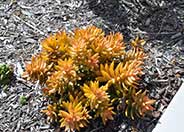
Common name:Orange Sedum
Botanical name:Sedum nussbaumeranian
This succulent perennial will grow best in a wall pot or hanging basket due to its long stems. It has light, gray green leaves that grow over one another to give off a "braided" look. The flowers are pink to deep red and bloom in spring and summer.

Common name:Coral Fountain, Firecracker Plant
Botanical name:Russelia equisetiformis
This heavy blooming shrub is from tropical Mexico. Coral Fountain can reach a mature size of about 5' tall and wide in frost-free climates. In colder climates, foliage will die back at freezing, but the plants will survive all but a hard frost. This is an excellent plant for containers, so plants can be moved to a sheltered location in winter for frost areas.
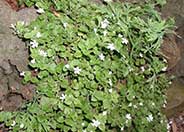
Common name:White Baccopa
Botanical name:Sutera cordata
White Baccopa is a prostrate ground cover with white flowers. It stays under 12" in height.
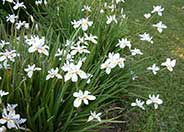
Common name:Butterfly-Iris, Fortnight Lily
Botanical name:Dietes iridioides
This clumping evergreen Iris bears tall, narrow leaves to 30" tall and white flowers marked purple in the center on stalks up to 3' tall. This variety has stiffer, darker foliage than the bicolor form. It requires sun to part shade with little or no summer watering when established.
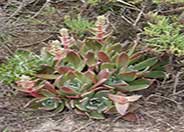
Common name:Dudleya
Botanical name:Dudleya cultivars
Dudleya cultivars are very numerous and they are typically low rosette shaped succulents. They are wonderful accent plants and work well in pots.
Maintenance Tips
Dudleya cultivars include a variety of low-growing, rosette-shaped succulents that are drought-tolerant and require very little maintenance. Most of these plants are native to the California and Mexican coasts, as well as the small adjacent islands. The majority of them prefer to be planted in full sun, along the coast, and in very well-drained soil. If they are planted in a garden with irrigation, it is often best to cut off the water to these plants in the summer as they are susceptible to root rot, especially when the weather is hot and humid. Almost all Dudleya will have old leaves that collect under the larger rosettes as they mature. These older leaves can be removed occasionally to keep the plant looking tidy.Designer: Susan Trindle
Photographer: GardenSoft
Incorporate compost 6" into your soil to retain water, reduce compaction, feed earthworms, and provide valuable nutrients to your plants.
Attract, or buy beneficial insects such as ladybugs and lacewings to control pest outbreaks in your garden.